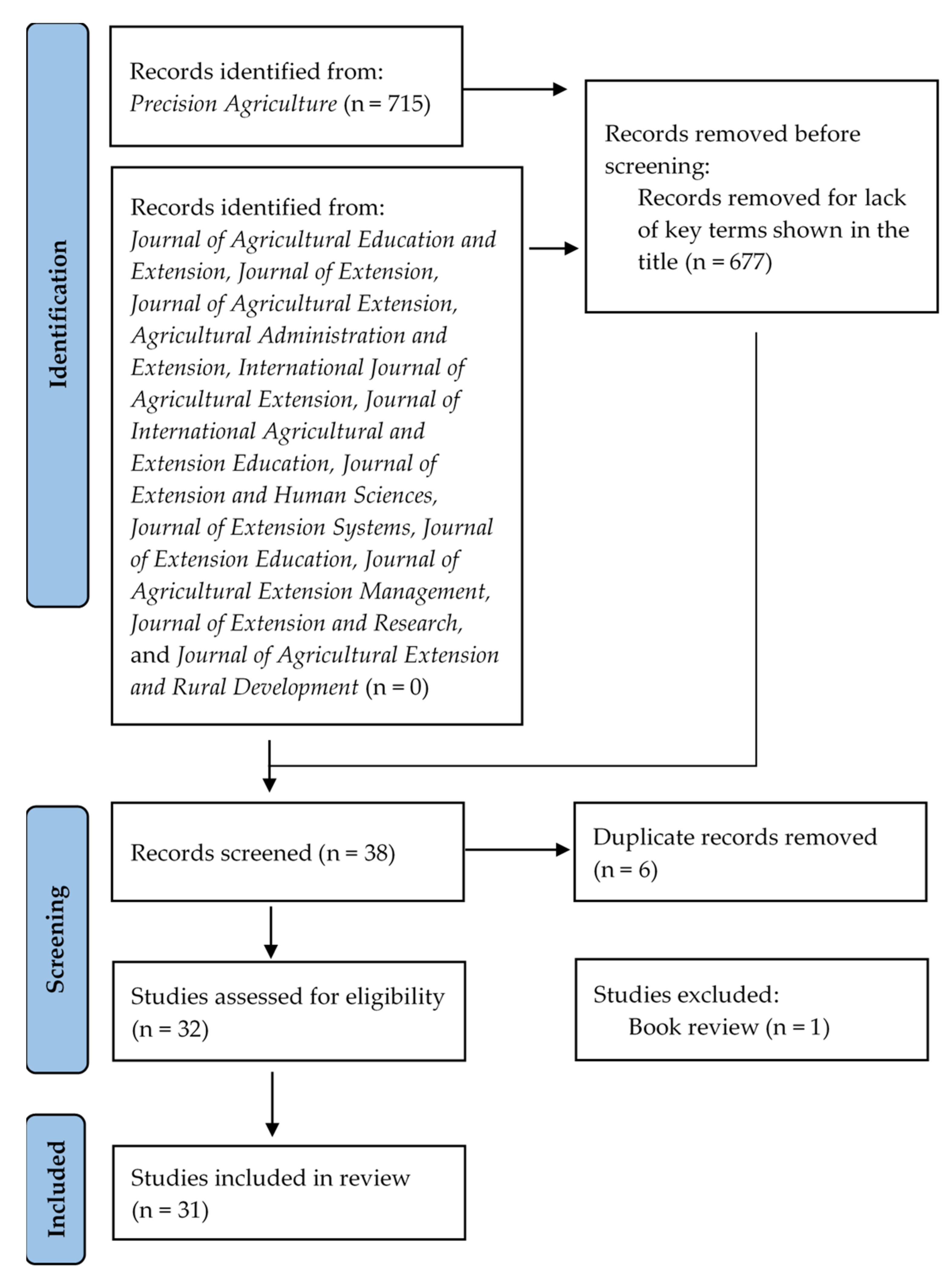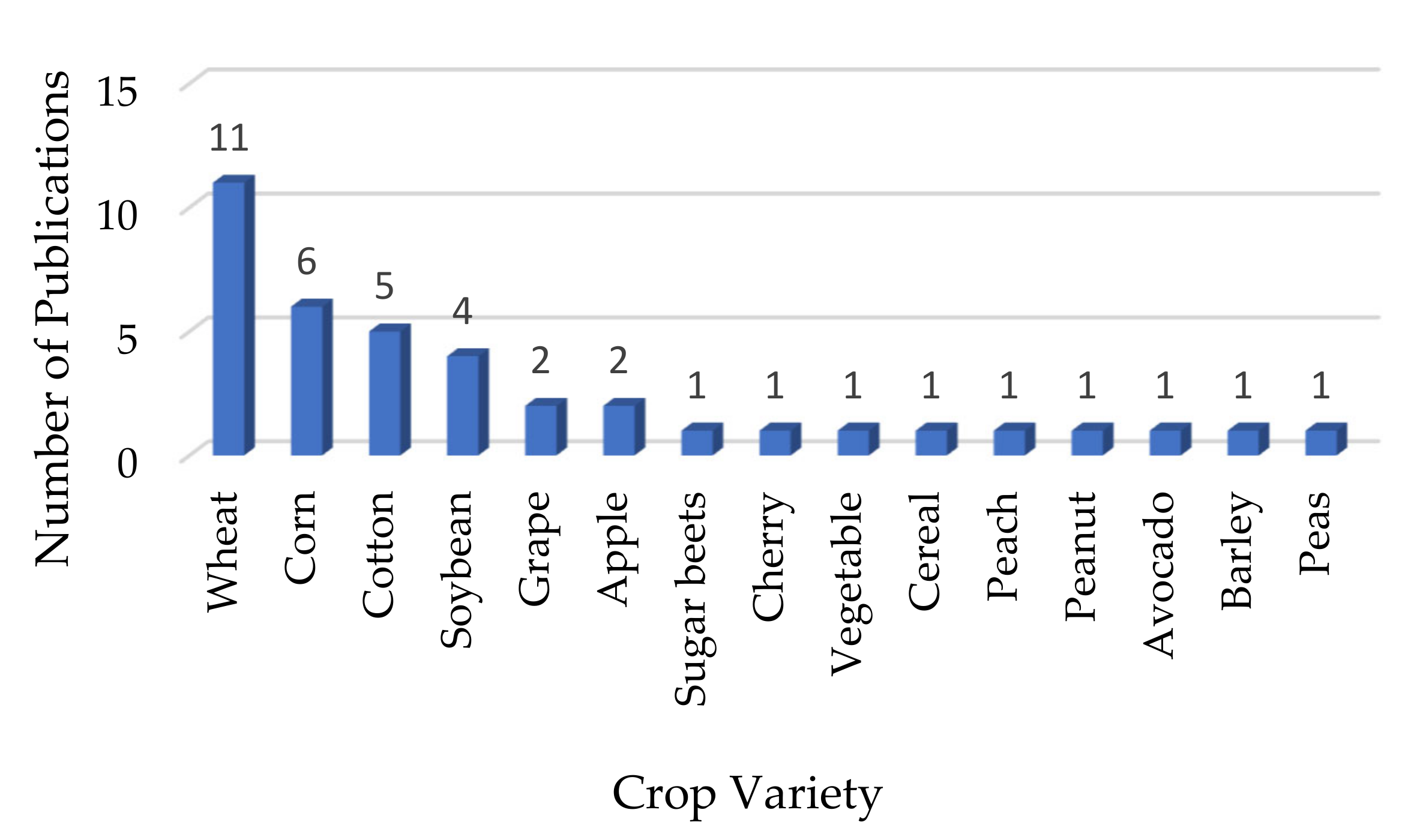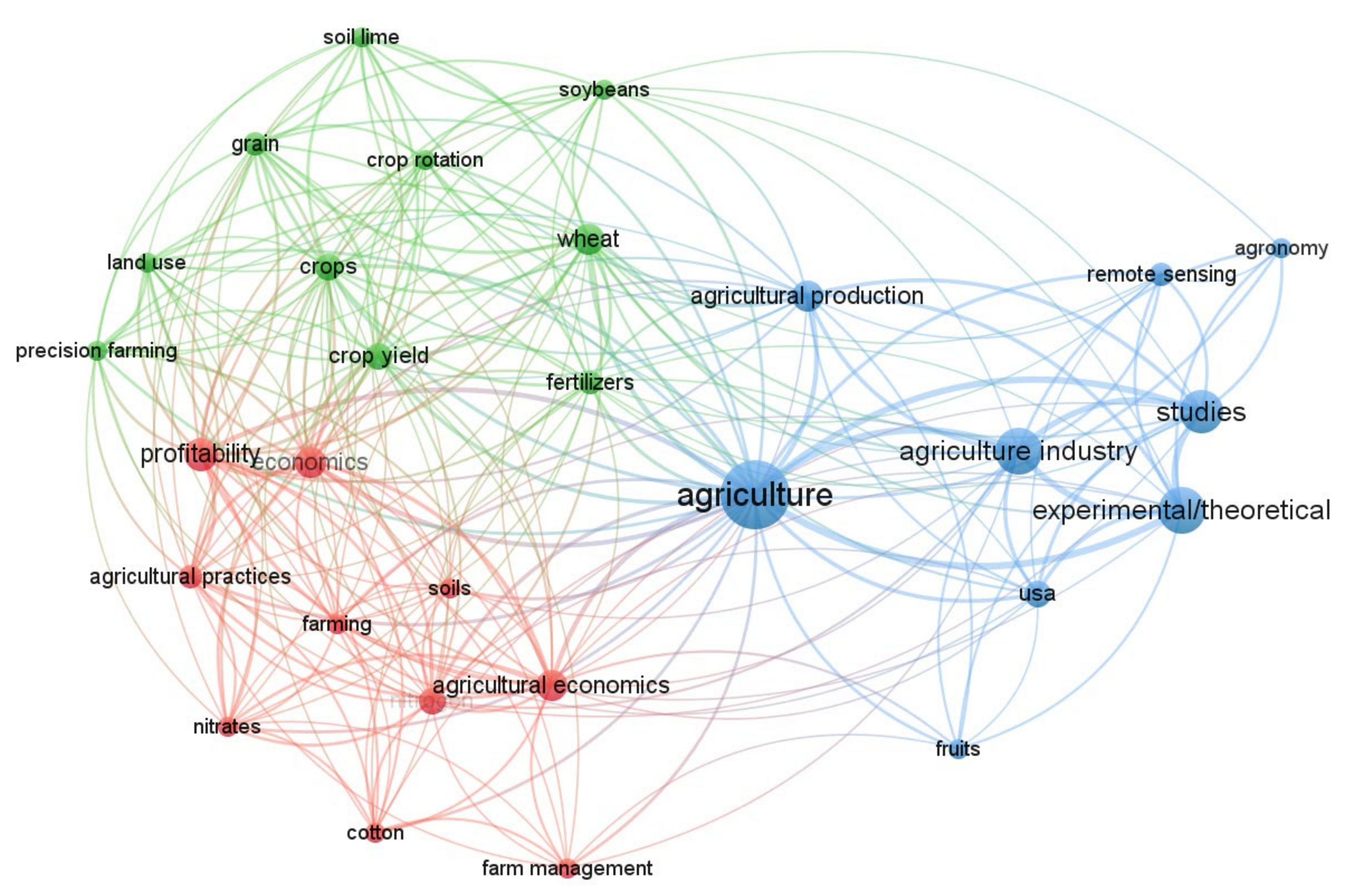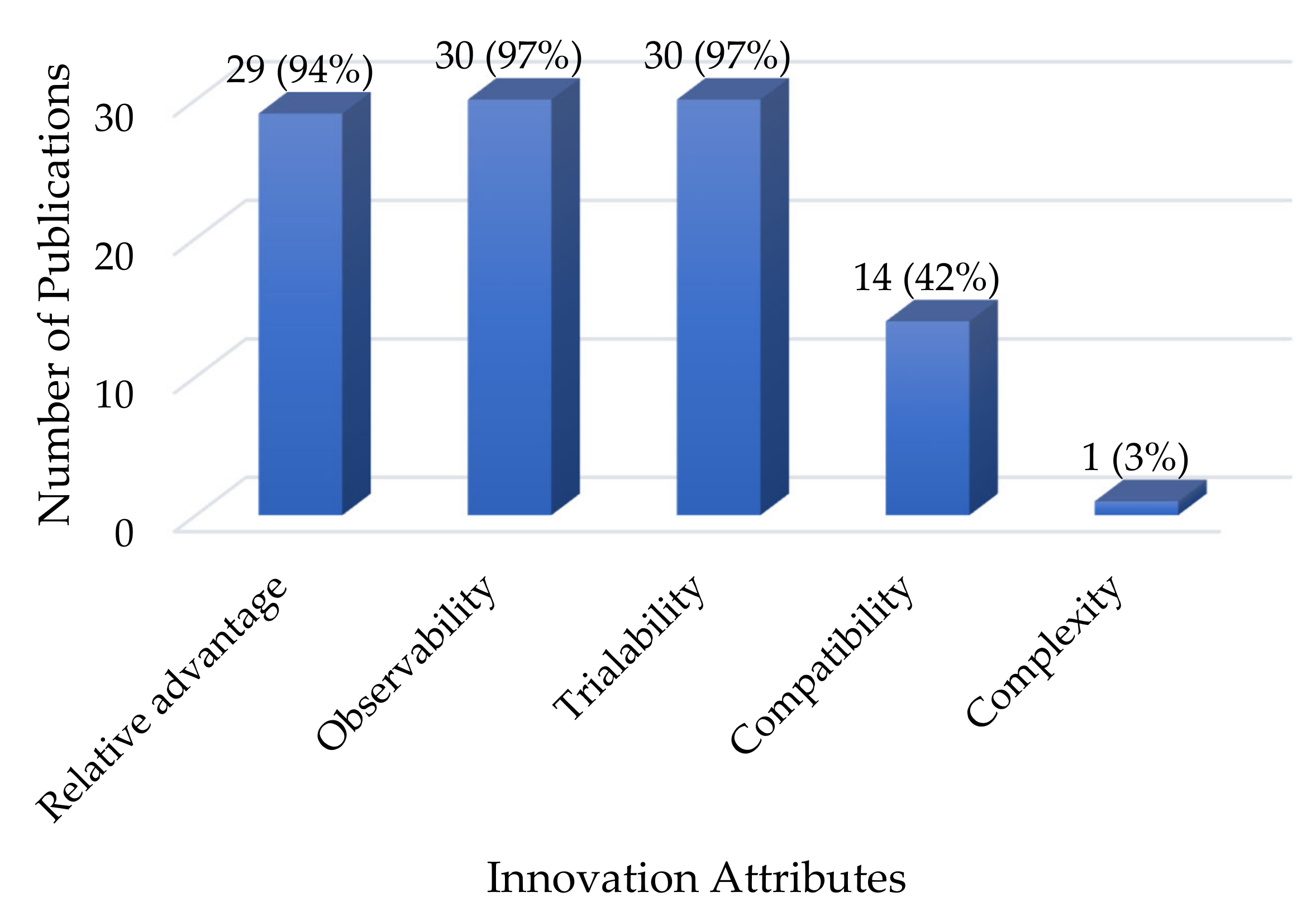Analyzing Precision Agriculture Adoption across the Globe: A Systematic Review of Scholarship from 1999–2020
Abstract
:1. Introduction
2. Materials and Methods
2.1. Inclusion/Exclusion Criteria
2.2. Data Extraction
2.3. Data Analysis
3. Results
3.1. Summary of Findings
3.2. Findings of Innovation Attributes
4. Discussion
5. Conclusions
Author Contributions
Funding
Institutional Review Board Statement
Informed Consent Statement
Data Availability Statement
Conflicts of Interest
References
- Thompson, R.J.; Storberg-Walker, J. Leadership and Power in International Development: Navigating the Intersections of Gender, Culture, Context, and Sustainability; Emerald Publishing Limited: Bingley, UK, 2018; p. 368. ISBN 978-1-7874-3999-3. [Google Scholar]
- Godfray, H.C.J.; Beddington, J.R.; Crute, I.R.; Haddad, L.; Lawrence, D.; Muir, J.F.; Pretty, J.; Robinson, S.; Thomas, S.M.; Toulmin, C. Food Security: The Challenge of Feeding 9 Billion People. Science 2010, 327, 812–818. [Google Scholar] [CrossRef] [PubMed] [Green Version]
- Basso, B.; Dobrowolski, J.; McKay, C. From the Dust Bowl to Drones to Big Data: The Next Revolution in Agriculture. Georget. J. Int. Aff. 2017, 18, 158–165. [Google Scholar] [CrossRef]
- Gallardo, R.K.; Sauer, J. Adoption of Labor-Saving Technologies in Agriculture. Annu. Rev. Resour. Econ. 2018, 10, 185–206. [Google Scholar] [CrossRef] [Green Version]
- Zambon, I.; Cecchini, M.; Egidi, G.; Saporito, M.G.; Colantoni, A. Revolution 4.0: Industry vs. Agriculture in a Future Development for SMEs. Processes 2019, 7, 36. [Google Scholar] [CrossRef] [Green Version]
- Wolde, Z.; Wei, W.; Kunpeng, W.; Ketema, H.; Wang, K. Local community perceptions toward livelihood and water–energy–food nexus: A perspective on food security. Food Energy Secur. 2020, 9, 1–15. [Google Scholar] [CrossRef]
- Afzal, A.; Al-Subaiee, F.S.; Mirza, A.A. The Attitudes of Agricultural Extension Workers towards the Use of E-Extension for Ensuring Sustainability in the Kingdom of Saudi Arabia. Sustainability 2016, 8, 980. [Google Scholar] [CrossRef] [Green Version]
- Arnés, E.; Díaz-Ambrona, C.G.H.; Marín-González, O.; Astier, M. Farmer Field Schools (FFSs): A tool for empowering sustainability and food security in peasant farming systems in the Nicaraguan Highlands. Sustainability 2018, 10, 3020. [Google Scholar] [CrossRef] [Green Version]
- Materia, V.C.; Giarè, F.; Klerkx, L. Increasing Knowledge Flows between the Agricultural Research and Advisory System in Italy: Combining Virtual and Non-virtual Interaction in Communities of Practice. J. Agric. Educ. Ext. 2014, 21, 203–218. [Google Scholar] [CrossRef]
- Jellason, N.P.; Conway, J.S.; Baines, R.N. Understanding impacts and barriers to adoption of climate-smart agriculture (CSA) practices in North-Western Nigerian drylands. J. Agric. Educ. Ext. 2021, 27, 55–72. [Google Scholar] [CrossRef]
- Dunne, A.; Markey, A.; Kinsella, J. Examining the reach of public and private agricultural advisory services and farmers’ perceptions of their quality: The case of county Laois in Ireland. J. Agric. Educ. Ext. 2019, 25, 401–414. [Google Scholar] [CrossRef]
- Mourhir, A.; Papageorgiou, E.I.; Kokkinos, K.; Rachidi, T. Exploring Precision Farming Scenarios Using Fuzzy Cognitive Maps. Sustainability 2017, 9, 1241. [Google Scholar] [CrossRef] [Green Version]
- Onyango, C.; Nyaga, J.; Wetterlind, J.; Söderström, M.; Piikki, K. Precision Agriculture for Resource Use Efficiency in Smallholder Farming Systems in Sub-Saharan Africa: A Systematic Review. Sustainability 2021, 13, 1158. [Google Scholar] [CrossRef]
- Paustian, M.; Theuvsen, L. Adoption of precision agriculture technologies by German crop farmers. Precis. Agric. 2017, 18, 701–716. [Google Scholar] [CrossRef]
- Balafoutis, A.; Beck, B.; Fountas, S.; Vangeyte, J.; Van Der Wal, T.; Soto, I.; Gómez-Barbero, M.; Barnes, A.; Eory, V. Precision Agriculture Technologies Positively Contributing to GHG Emissions Mitigation, Farm Productivity and Economics. Sustainability 2017, 9, 1339. [Google Scholar] [CrossRef] [Green Version]
- Loures, L.; Chamizo, A.; Ferreira, P.; Loures, A.; Castanho, R.; Panagopoulos, T. Assessing the Effectiveness of Precision Agriculture Management Systems in Mediterranean Small Farms. Sustainability 2020, 12, 3765. [Google Scholar] [CrossRef]
- Ullah, A.; Nawaz, A.; Farooq, M.; Siddique, K. Agricultural Innovation and Sustainable Development: A Case Study of Rice–Wheat Cropping Systems in South Asia. Sustainability 2021, 13, 1965. [Google Scholar] [CrossRef]
- Yue, Y.; Zhou, Y.; Wang, J.; Ye, X. Assessing wheat frost risk with the support of GIS: An approach coupling and growing season meterological index and a hybrid fuzzy neutral network model. Sustainability 2016, 8, 1308. [Google Scholar] [CrossRef] [Green Version]
- International Society of Precision Agriculture. Precision ag Definition: International Society of Precision Agriculture; International Society of Precision Agriculture: Monticello, IL, USA, 2019; Available online: https://www.ispag.org/about/definition (accessed on 13 July 2021).
- Bosompem, M. Potential challenges to precision agriculture technologies development in Ghana: Scientists’ and cocoa extension agents’ perspectives. Precis. Agric. 2021, 22, 1578–1600. [Google Scholar] [CrossRef]
- Bramley, R.G.V. Lessons from nearly 20 years of Precision Agriculture research, development, and adoption as a guide to its appropriate application. Crop Pasture Sci. 2009, 60, 197–217. [Google Scholar] [CrossRef]
- Fountas, S.; Pedersen, S.M.; Blackmore, S. ICT in Precision Agriculture—Diffusion of Technology an Overview of Precision Agriculture. ICT in Agriculture: Perspective of Technological Innovation; Gelb, E., Offer, A., Eds.; ResearchGate: Berlin, Germany, 2004. [Google Scholar] [CrossRef]
- Schimmelpfennig, D.; Ebel, R. Sequential Adoption and Cost Savings from Precision Agriculture. J. Agric. Resour. Econ. 2016, 41, 97–115. Available online: http://www.jstor.org/stable/44131378 (accessed on 22 April 2021).
- Pathak, H.S.; Brown, P.; Best, T. A systematic literature review of the factors affecting the precision agriculture adoption process. Precis. Agric. 2019, 20, 1292–1316. [Google Scholar] [CrossRef]
- Kernecker, M.; Knierim, A.; Wurbs, A.; Kraus, T.; Borges, F. Experience versus expectation: Farmers’ perceptions of smart farming technologies for cropping systems across Europe. Precis. Agric. 2020, 21, 34–50. [Google Scholar] [CrossRef]
- Lowenberg-DeBoer, J.; Erickson, B. Setting the Record Straight on Precision Agriculture Adoption. Agron. J. 2019, 111, 1552–1569. [Google Scholar] [CrossRef] [Green Version]
- Robertson, M.J.; Llewellyn, R.; Mandel, R.; Lawes, R.; Bramley, R.; Swift, L.; Metz, N.; O’Callaghan, C. Adoption of variable rate fertiliser application in the Australian grains industry: Status, issues and prospects. Precis. Agric. 2012, 13, 181–199. [Google Scholar] [CrossRef]
- Sarri, D.; Lombardo, S.; Pagliai, A.; Perna, C.; Lisci, R.; De Pascale, V.; Rimediotti, M.; Cencini, G.; Vieri, M. Smart Farming Introduction in Wine Farms: A Systematic Review and a New Proposal. Sustainability 2020, 12, 7191. [Google Scholar] [CrossRef]
- Cosby, A.M.; Falzon, G.A.; Trotter, M.G.; Stanley, J.N.; Powell, K.S.; Lamb, D.W. Risk mapping of redheaded cockchafer (Adoryphorus couloni) (Burmeister) infestations using a combination of novel k-means clustering and on-the-go plant and soil sensing technologies. Precis. Agric. 2016, 17, 1–17. [Google Scholar] [CrossRef]
- Rogovska, N.; Laird, D.A.; Chiou, C.-P.; Bond, L.J. Development of field mobile soil nitrate sensor technology to facilitate precision fertilizer management. Precis. Agric. 2019, 20, 40–55. [Google Scholar] [CrossRef]
- Rogers, E.M. Diffusion of Innovations, 5th ed.; Free Press: New York, NY, USA, 2003; p. 551. ISBN 978-0-7432-2209-9. [Google Scholar]
- Luck, J.; Fulton, J.; Rees, J. Hands-On Precision Agriculture Data Management Workshops for Producers and Industry Professionals: Development and Assessment. 2015, Volume 53. Available online: https://archives.joe.org/joe/2015august/tt10.php (accessed on 26 April 2021).
- Asseng, S.; Asche, F. Future farms without farmers. Sci. Robot. 2019, 4, eaaw1875. [Google Scholar] [CrossRef]
- Saiz-Rubio, V.; Rovira-Más, F. From Smart Farming towards Agriculture 5.0: A Review on Crop Data Management. Agronomy 2020, 10, 207. [Google Scholar] [CrossRef] [Green Version]
- Vindrola-Padros, C.; Brage, E.; Johnson, G.A. Rapid, Responsive, and Relevant? A Systematic Review of Rapid Evaluations in Health Care. Am. J. Eval. 2021, 42, 13–27. [Google Scholar] [CrossRef]
- Wright, R.W.; A Brand, R.; Dunn, W.; Spindler, K.P. How to Write a Systematic Review. Clin. Orthop. Relat. Res. 2007, 455, 23–29. [Google Scholar] [CrossRef] [Green Version]
- Ravikumar, S.; Agrahari, A.; Singh, S.N. Mapping the intellectual structure of scientometrics: A co-word analysis of the journal Scientometrics (2005–2010). Scientometrics 2015, 102, 929–955. [Google Scholar] [CrossRef]
- Chen, X.; Chen, J.; Wu, D.; Xie, Y.; Li, J. Mapping the Research Trends by Co-word Analysis Based on Keywords from Funded Project. Procedia Comput. Sci. 2016, 91, 547–555. [Google Scholar] [CrossRef] [Green Version]
- Karatay, Y.N.; Meyer-Aurich, A. Profitability and downside risk implications of site-specific nitrogen management with respect to wheat grain quality. Precis. Agric. 2020, 21, 449–472. [Google Scholar] [CrossRef]
- Mills, B.E.; Brorsen, W.; Arnall, D.B. The profitability of variable rate lime in wheat. Precis. Agric. 2020, 21, 369–386. [Google Scholar] [CrossRef]
- Stamatiadis, S.; Schepers, J.S.; Evangelou, E.; Glampedakis, A.; Dercas, N.; Tsadilas, C.; Tserlikakis, N.; Tsadila, E. Variable-rate application of high spatial resolution can improve cotton N-use efficiency and profitability. Precis. Agric. 2020, 21, 695–712. [Google Scholar] [CrossRef]
- Yost, M.A.; Kitchen, N.R.; Sudduth, K.A.; Massey, R.E.; Sadler, E.J.; Drummond, S.T.; Volkmann, M.R. A long-term precision agriculture system sustains grain profitability. Precis. Agric. 2019, 20, 1177–1198. [Google Scholar] [CrossRef]
- Stefanini, M.; Larson, J.A.; Lambert, D.M.; Yin, X.; Boyer, C.N.; Scharf, P.; Tubaña, B.S.; Varco, J.J.; Dunn, D.; Savoy, H.J.; et al. Effects of optical sensing based variable rate nitrogen management on yields, nitrogen use and profitability for cotton. Precis. Agric. 2019, 20, 591–610. [Google Scholar] [CrossRef]
- Tona, E.; Calcante, A.; Oberti, R. The profitability of precision spraying on specialty crops: A technical–economic analysis of protection equipment at increasing technological levels. Precis. Agric. 2018, 19, 606–629. [Google Scholar] [CrossRef] [Green Version]
- Larson, J.A.; Velandia, M.M.; Buschermohle, M.J.; Westlund, S.M. Effect of field geometry on profitability of automatic section control for chemical application equipment. Precis. Agric. 2016, 17, 18–35. [Google Scholar] [CrossRef]
- Boyer, C.N.; Brorsen, B.W.; Solie, J.B.; Raun, W. Profitability of variable rate nitrogen application in wheat production. Precis. Agric. 2011, 12, 473–487. [Google Scholar] [CrossRef]
- Maine, N.; Lowenberg-DeBoer, J.; Nell, W.T.; Alemu, Z.G. Impact of variable-rate application of nitrogen on yield and profit: A case study from South Africa. Precis. Agric. 2010, 11, 448–463. [Google Scholar] [CrossRef]
- O’Neal, M.; Frankenberger, J.R.; Ess, D.R.; Lowenberg-DeBoer, J. Profitability of On-Farm Precipitation Data for Nitrogen Management Based on Crop Simulation. Precis. Agric. 2004, 5, 153–178. [Google Scholar] [CrossRef]
- Young, D.L.; Kwon, T.J.; Smith, E.G.; Young, F.L. Site-Specific Herbicide Decision Model to Maximize Profit in Winter Wheat. Precis. Agric. 2003, 4, 227–238. [Google Scholar] [CrossRef]
- Reyns, P.; Spaepen, P.; De Baerdemaeker, J. Site-Specific Relationship Between Grain Quality and Yield. Precis. Agric. 2000, 2, 231–246. [Google Scholar] [CrossRef]
- Martínez, J.; Egea, G.; Agüera, J.; Pérez-Ruiz, M. A cost-effective canopy temperature measurement system for precision agriculture: A case study on sugar beet. Precis. Agric. 2017, 18, 95–110. [Google Scholar] [CrossRef]
- Pavuluri, K.; Chim, B.K.; Griffey, C.A.; Reiter, M.S.; Balota, M.; Thomason, W.E. Canopy spectral reflectance can predict grain nitrogen use efficiency in soft red winter wheat. Precis. Agric. 2015, 16, 405–424. [Google Scholar] [CrossRef]
- Ampatzidis, Y.G.; Whiting, M.D.; Liu, B.; Scharf, P.A.; Pierce, F.J. Portable weighing system for monitoring picker efficiency during manual harvest of sweet cherry. Precis. Agric. 2013, 14, 162–171. [Google Scholar] [CrossRef]
- Ortiz, B.V.; Balkcom, K.B.; Duzy, L.; Van Santen, E.; Hartzog, D.L. Evaluation of agronomic and economic benefits of using RTK-GPS-based auto-steer guidance systems for peanut digging operations. Precis. Agric. 2013, 14, 357–375. [Google Scholar] [CrossRef]
- Gómez-candón, D.; López-granados, F.; Caballero-novella, J.J.; García-ferrer, A.; Peña-barragán, J.M.; Jurado-expósito, M.; García-torres, L. Sectioning remote imagery for characterization of Avena sterilis infestations. Part B: Efficiency and economics of control. Precis. Agric. 2012, 13, 337–350. [Google Scholar] [CrossRef] [Green Version]
- Rascher, U.; Pieruschka, R. Spatio-temporal variations of photosynthesis: The potential of optical remote sensing to better understand and scale light use efficiency and stresses of plant ecosystems. Precis. Agric. 2008, 9, 355–366. [Google Scholar] [CrossRef]
- Torbett, J.C.; Roberts, R.K.; Larson, J.A.; English, B.C. Perceived importance of precision farming technologies in improving phosphorus and potassium efficiency in cotton production. Precis. Agric. 2007, 8, 127–137. [Google Scholar] [CrossRef]
- Biermacher, J.T.; Epplin, F.M.; Brorsen, B.W.; Solie, J.B.; Raun, W.R. Maximum benefit of a precise nitrogen application system for wheat. Precis. Agric. 2006, 7, 193–204. [Google Scholar] [CrossRef]
- Krell, R.K.; Pedigo, L.P.; Babcock, B.A. Comparison of Estimated Costs and Benefits of Site-Specific Versus Uniform Management for the Bean Leaf Beetle in Soybean. Precis. Agric. 2003, 4, 401–411. [Google Scholar] [CrossRef]
- Holland, J.E.; Cammarano, D.; Fitzgerald, G.J.; Perry, E.M.; Poile, G.; Conyers, M.K. Proximal fluorescence sensing of potassium responsive crops to develop improved predictions of biomass, yield and grain quality of wheat and barley. Precis. Agric. 2019, 20, 379–397. [Google Scholar] [CrossRef]
- Uribeetxebarria, A.; Martínez-Casasnovas, J.A.; Escolà, A.; Rosell-Polo, J.R.; Arnó, J. Stratified sampling in fruit orchards using cluster-based ancillary information maps: A comparative analysis to improve yield and quality estimates. Precis. Agric. 2019, 20, 179–192. [Google Scholar] [CrossRef] [Green Version]
- Arnó, J.; Rosell, J.R.; Blanco, R.; Ramos, M.C.; Martínez-Casasnovas, J.A. Spatial variability in grape yield and quality influenced by soil and crop nutrition characteristics. Precis. Agric. 2012, 13, 393–410. [Google Scholar] [CrossRef] [Green Version]
- Aggelopoulou, K.D.; Wulfsohn, D.; Fountas, S.; Gemtos, T.A.; Nanos, G.D.; Blackmore, S. Spatial variation in yield and quality in a small apple orchard. Precis. Agric. 2010, 11, 538–556. [Google Scholar] [CrossRef]
- Link, J.; Batchelor, W.D.; Graeff, S.; Claupein, W. Evaluation of current and model-based site-specific nitrogen applications on wheat (Triticum aestivum L.) yield and environmental quality. Precis. Agric. 2008, 9, 251–267. [Google Scholar] [CrossRef]
- Jørgensen, J.R.; Jørgensen, R.N. Uniformity of wheat yield and quality using sensor assisted application of nitrogen. Precis. Agric. 2007, 8, 63–73. [Google Scholar] [CrossRef]
- Miao, Y.; Mulla, D.J.; Robert, P.C. Spatial Variability of Soil Properties, Corn Quality and Yield in Two Illinois, USA Fields: Implications for Precision Corn Management. Precis. Agric. 2006, 7, 5–20. [Google Scholar] [CrossRef]
- Miao, Y.; Mulla, D.J.; Robert, P.C. Identifying important factors influencing corn yield and grain quality variability using artificial neural networks. Precis. Agric. 2006, 7, 117–135. [Google Scholar] [CrossRef]
- Kountios, G.; Ragkos, A.; Bournaris, T.; Papadavid, G.; Michailidis, A. Educational needs and perceptions of the sustainability of precision agriculture: Survey evidence from Greece. Precis. Agric. 2018, 19, 537–554. [Google Scholar] [CrossRef]
- Bongiovanni, R.; Lowenberg-Deboer, J. Precision Agriculture and Sustainability. Precis. Agric. 2004, 5, 359–387. [Google Scholar] [CrossRef]
- Lin, P.; Lee, W.S.; Chen, Y.M.; Peres, N.; Fraisse, C. A deep-level region-based visual representation architecture for detecting strawberry flowers in an outdoor field. Precis. Agric. 2020, 21, 387–402. [Google Scholar] [CrossRef]
- Jensen, H.G.; Jacobsen, L.-B.; Pedersen, S.M.; Tavella, E. Socioeconomic impact of widespread adoption of precision farming and controlled traffic systems in Denmark. Precis. Agric. 2012, 13, 661–677. [Google Scholar] [CrossRef]
- Silva, C.B.; De Moraes, M.A.F.D.; Molin, J.P. Adoption and use of precision agriculture technologies in the sugarcane industry of São Paulo state, Brazil. Precis. Agric. 2011, 12, 67–81. [Google Scholar] [CrossRef]
- Altalb, A.A.T.; Filipek, T.; Skowron, P. The role of agricultural extension in the transfer and adoption of agricultural technologies. Asian J. Agric. Food Sci. 2015, 3, 500–507. Available online: https://ajouronline.com/index.php/AJAFS/article/view/2962 (accessed on 26 April 2021).






| Terms | T1: Production | T2: Quality | T3: Yield |
| T4: Crop | T5: Profitability | T6: Profit | |
| T7: Efficiency | T8: Resource | T9: Benefit | |
| T10: Effectiveness | T11: Investments | T12: Labor | |
| T13: Worker | T14: Sustainability | T15: Environment | |
| T16: Impact | T17: Reduce | T18: Precision agriculture | |
| Combinations | C1: T1 and T2 | C2: T2 and T3 | C3: T3 and T4 |
| C4: T3 and T6 | C5: T7 and T8 | C6: T9 and T10 | |
| C7: T15 and T16 | C8: T16 and T17 |
| Coded Theme | Data Collection Process |
|---|---|
| Production quality |
|
| Improved profitability |
|
| Improved the efficiency of resource use |
|
| Environmental sustainability |
|
| Inclusion Criteria | Exclusion Criteria |
|---|---|
| Publication type was a peer-reviewed article | Publication type was nonpeer-review |
| Articles were written in English | Articles were not written in English |
| Search terms appearing in the title of articles | Search terms other than in the title |
| Published in the period (1999–2020) | Published prior to 1999 |
| Literature | Title | Crop | Country |
|---|---|---|---|
| Karatay and Meyer-Aurich [39] | Profitability and downside risk implications of site-specific nitrogen management with respect to wheat grain quality | wheat | Germany |
| Mills et al. [40] | The profitability of variable rate lime in wheat | wheat | USA |
| Stamatiadis et al. [41] | Variable-rate application of high spatial resolution can improve cotton N-use efficiency and profitability | cotton | Greece |
| Yost et al. [42] | A long-term precision agriculture system sustains grain profitability | corn; soybean | USA |
| Stefanini et al. [43] * | Effects of optical sensing based variable rate nitrogen management on yields, nitrogen use and profitability for cotton | cotton | USA |
| Tona et al. [44] | The profitability of precision spraying on specialty crops: a technical–economic analysis of protection equipment at increasing technological levels | grapevine; apple | Central-Southern Europe |
| Larson et al. [45] | Effect of field geometry on profitability of automatic section control for chemical application equipment | cotton | USA |
| Boyer et al. [46] | Profitability of variable rate nitrogen application in wheat production | wheat | USA |
| Maine et al. [47] | Impact of variable-rate application of nitrogen on yield and profit: a case study from South Africa | N/A | South Africa |
| O’Neal et al. [48] | Profitability of On-Farm Precipitation Data for Nitrogen Management Based on Crop Simulation | corn; soybean | USA |
| Young et al. [49] | Site-Specific Herbicide Decision Model to Maximize Profit in Winter Wheat | wheat; peas | USA |
| Reyns et al. [50] | Site-Specific Relationship Between Grain Quality and Yield | wheat | Belgium |
| Literature | Title | Crop | Country |
|---|---|---|---|
| Stamatiadis et al. [41] * | Variable-rate application of high spatial resolution can improve cotton N-use efficiency and profitability | cotton | Greece |
| Martinez et al. [51] | A cost-effective canopy temperature measurement system for precision agriculture: a case study on sugar beet | sugar beets | Spain |
| Pavuluri et al. [52] | Canopy spectral reflectance can predict grain nitrogen use efficiency in soft red winter wheat | wheat | USA |
| Ampatzidis et al. [53] | Portable weighing system for monitoring picker efficiency during manual harvest of sweet cherry | cherry tree | USA |
| Ortiz et al. [54] | Evaluation of agronomic and economic benefits of using RTK-GPS-based auto-steer guidance systems for peanut digging operations | peanut | USA |
| Go’mez-Cando’n et al. [55] | Sectioning remote imagery for characterization of Avena sterilis infestations. Part B: Efficiency and economics of control | wheat | Spain |
| Rascher and Pieruschka [56] | Spatio-temporal variations of photosynthesis: the potential of optical remote sensing to better understand and scale light use efficiency and stresses of plant ecosystems | soybean; avocado | USA |
| Torbett et al. [57] | Perceived importance of precision farming technologies in improving phosphorus and potassium efficiency in cotton production | cotton | USA |
| Biermacher et al. [58] | Maximum benefit of a precise nitrogen application system for wheat | wheat | USA |
| Krell and Pedigo [59] | Comparison of Estimated Costs and Benefits of Site-Specific Versus Uniform Management for the Bean Leaf Beetle in Soybean | soybean-corn rotation | USA |
| Literature | Title | Crop | Country |
|---|---|---|---|
| Holland et al. [60] | Proximal fluorescence sensing of potassium responsive crops to develop improved predictions of biomass, yield and grain quality of wheat and barley | wheat; barley | Australia |
| Uribeetxebarria et al. [61] | Stratified sampling in fruit orchards using cluster-based ancillary information maps: a comparative analysis to improve yield and quality estimates | peach | Spain |
| Arno et al. [62] | Spatial variability in grape yield and quality influenced by soil and crop nutrition characteristics | grape | Spain |
| Aggelopulou et al. [63] | Spatial variation in yield and quality in a small apple orchard | apple | Greece |
| Link et al. [64] | Evaluation of current and model-based site-specific nitrogen applications on wheat (Triticum aestivum L.) yield and environmental quality | wheat | Germany |
| Jørgensen and Jørgensen [65] | Uniformity of wheat yield and quality using sensor assisted application of nitrogen | wheat | Denmark |
| Miao et al. [66] | Spatial variability of soil properties, corn quality and yield in two Illinois, USA fields: implications for precision corn management | corn | USA |
| Miao et al. [67] | Identifying important factors influencing corn yield and grain quality variability using artificial neural networks | corn | USA |
| Reyns et al. [50] * | Site-Specific Relationship Between Grain Quality and Yield | wheat | Belgium |
| Literature | Title | Crop | Country |
|---|---|---|---|
| Kountios et al. [68] | Educational needs and perceptions of the sustainability of precision agriculture: survey evidence from Greece | cotton; vegetable; cereal | Greece |
| Bongiovanni et al. [69] | Precision agriculture and sustainability | corn | Argentina |
Publisher’s Note: MDPI stays neutral with regard to jurisdictional claims in published maps and institutional affiliations. |
© 2021 by the authors. Licensee MDPI, Basel, Switzerland. This article is an open access article distributed under the terms and conditions of the Creative Commons Attribution (CC BY) license (https://creativecommons.org/licenses/by/4.0/).
Share and Cite
Lee, C.-L.; Strong, R.; Dooley, K.E. Analyzing Precision Agriculture Adoption across the Globe: A Systematic Review of Scholarship from 1999–2020. Sustainability 2021, 13, 10295. https://doi.org/10.3390/su131810295
Lee C-L, Strong R, Dooley KE. Analyzing Precision Agriculture Adoption across the Globe: A Systematic Review of Scholarship from 1999–2020. Sustainability. 2021; 13(18):10295. https://doi.org/10.3390/su131810295
Chicago/Turabian StyleLee, Chin-Ling, Robert Strong, and Kim E. Dooley. 2021. "Analyzing Precision Agriculture Adoption across the Globe: A Systematic Review of Scholarship from 1999–2020" Sustainability 13, no. 18: 10295. https://doi.org/10.3390/su131810295
APA StyleLee, C.-L., Strong, R., & Dooley, K. E. (2021). Analyzing Precision Agriculture Adoption across the Globe: A Systematic Review of Scholarship from 1999–2020. Sustainability, 13(18), 10295. https://doi.org/10.3390/su131810295








